Source: Zhongjin Dianxing
Election Situation: Trump Still Leads, but the Lead Has Narrowed
Trump still maintains a lead in swing states. As of November 1, in national polls, still leads, with a support rate of 48.4%, leading by about 0.3 percentage points. In comparison, in the same period in the 2016 and 2020 elections, trailed by 7.8 and 1.5 percentage points, respectively. From the perspective of swing states, maintains a lead, but it has narrowed slightly compared to a week ago, and has surpassed in Michigan and Wisconsin. Referring to the current polls, if we assume that the electoral votes are allocated according to the current polls in each state, and will win 287 and 251 votes, respectively (270 votes are the threshold for victory).
Chart: maintains a lead, but it has narrowed slightly compared to a week ago, and has surpassed in Michigan and Wisconsin
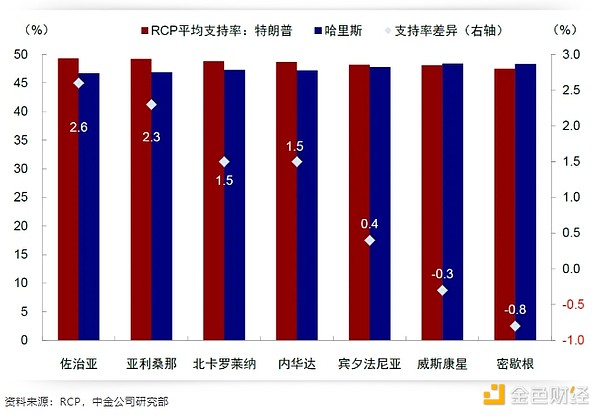
Looking at the faster-changing betting market, 's betting odds advantage has narrowed significantly recently. According to RCP's aggregation of data from various platforms, as of November 2, 2024, 's betting odds are 54.7% vs. 's 44.1%, significantly narrower than the 63.9% at the end of October.
Chart: 's betting odds are 54.7% vs. 's 44.1%, significantly narrower than the 63.9% at the end of October
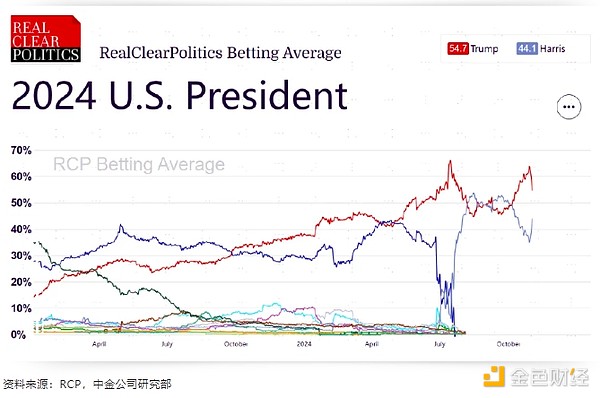
Early Voting: Democrats Have a Higher Proportion, but Relying Solely on Party Affiliation to Judge the Lead Advantage Is Not Reliable
Early voting and mail-in ballots are expected to account for as much as 65% of the vote this year. The United States has nearly 170 million registered voters, and the voter turnout in the 2020 election was about 66% (the number of votes cast as a percentage of the eligible voting population), the highest in more than a century. Based on our estimate of 245 million eligible voters in 2024 and a 66% turnout rate in 2020, the total number of votes in 2024 may reach 160 million. As of November 1, early voting (including in-person and mail-in) has reached 70 million votes, accounting for 43% of the total votes, and if we add the mail-in ballots that have not yet been returned (but these ballots may not be fully returned), the early voting number may reach 100 million, accounting for 65% of the estimated total votes. The proportion of early voting in the 2020 and 2016 elections was 64% and 36.6%, respectively, and it is still at a relatively high level this year.
Chart: The estimated total number of votes in 2024 is 160 million
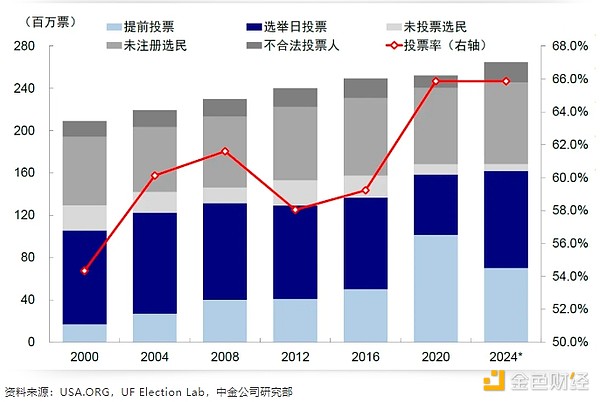
Chart: The current estimated proportion of early voting is at a relatively high level
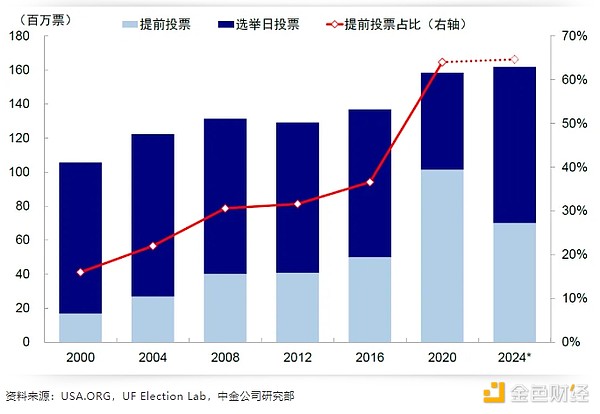
The proportion of registered Democrats among early voters is higher than that of Republicans, but using this as a reference for the final result is of limited reliability. Of the current 70 million early votes, according to UF Election Lab data, the proportion of registered Democrats and Republicans is 38.2% and 36.1%, respectively, with little difference. CNBC data also shows them both at around 40%. Among the early votes, Democrats have more voted by mail (Democrats 42.6% vs. Republicans 33.5%), while Republicans have a higher proportion of in-person voting (Republicans 39.7% vs. Democrats 31.7%). However, in some swing states, especially the focus of this election, Pennsylvania, UF Election Lab estimates that the proportion of registered Democrats among early voters is 56%, significantly higher than the 33% of registered Republicans, seemingly giving an advantage. However, early voting does not mean early counting, and registered party members do not constitute the vast majority of voters in the United States, and the proportion of early voting in the key swing state of Pennsylvania is not high (24%), so relying solely on early voting and party affiliation in early voting to judge the lead advantage is not reliable.
Chart: Based on the registered party affiliation of early voters in swing states, has a greater lead advantage, but there is still a lot of uncertainty in the final election result

Chart: Party affiliation of early voters in each state
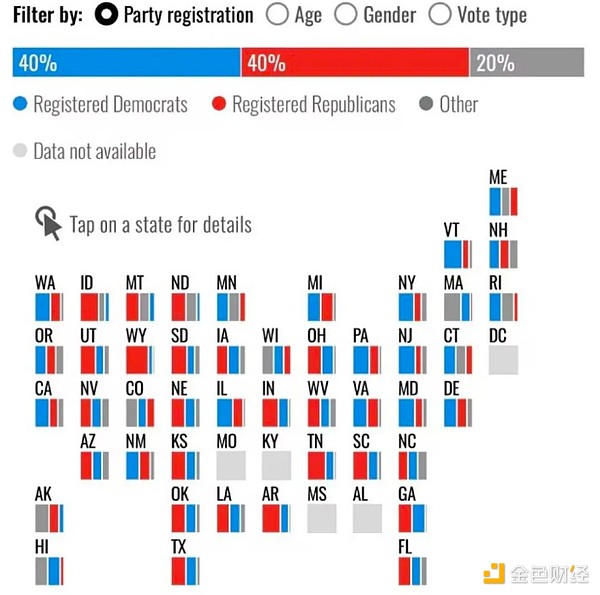
Viewing Guide: Most Polling Stations in Beijing Time Will Close Around Noon on the 6th, and the Results May Be Released in the Evening, with Pennsylvania as the "Tiebreaker"
As the November 5 election day approaches, how to track the real-time election situation and when the results will be available are issues of great concern to everyone.
1. How long will the voting take? The polls will open and close in sequence from east to west, and will be basically closed by noon Beijing time on the 6th
Due to the difference in time zones, the polling stations in different parts of the United States will open and close on November 5 at different times, generally closing in sequence from east to west. For example, some of the first polling stations to close will be in parts of Indiana and Kentucky, closing at 6 p.m. Eastern Time (6 a.m. Beijing time on the 6th). The last state to close its polling stations will be Alaska, between 12 noon and 1 p.m. Beijing time on the 6th.
The voting deadline for the seven key swing states is (all in Beijing time): Georgia, 7 a.m. on the 6th; North Carolina, 7:30 a.m. on the 6th; Pennsylvania, 8 a.m. on the 6th; Michigan, 8-9 a.m. on the 6th; Arizona, 9 a.m. on the 6th; Wisconsin, 9 a.m. on the 6th; Nevada, 10 a.m. on the 6th.
Chart: The last swing state, Nevada, will close its polling stations at 10 a.m. Beijing time on the 6th

2. When will the results be released? Possibly in the evening of the 6th in Beijing time
The counting rules and timing vary by state. Some states count the votes as they are cast on election day, while others allow counting to begin before election day. Shortly after the polling stations close, a considerable portion of the vote results have already been tabulated, and the remaining ballots usually do not significantly affect the overall outcome, unless the race is extremely close. Therefore, under normal circumstances, the final results are generally released no later than late at night on election day, which would be around noon Beijing time on the 6th. However, if there are more mail-in ballots or a recount is triggered, the release of the results may be delayed. Given the higher proportion of mail-in ballots this time and the rules in some swing states not allowing pre-counting, the final results may be slightly delayed, but they should be available by the afternoon or evening of the 6th in Beijing time. If the results in a key swing state are extremely close, a recount may further delay the release of the results. Specifically, for the seven key swing states, the following are the details of the vote counting (all in Beijing time):
► Georgia: May be the first to release results. Georgia has a high proportion of early voting (80%), and has been processing mail-in ballots since October 21, with the requirement that mail-in ballots must be postmarked by the time the polls close. It is expected that 90% of the counting will be completed by 10:30 a.m. on the 6th in Beijing time. Georgia does not have an automatic recount trigger, but if the final margin is less than or equal to 0.5% of the total votes, the candidate can request a recount.
► North Carolina: Results may be obtained at noon on the 6th. The proportion of early voting in North Carolina is also relatively high (75%), and this year's new rules require that mail-in ballots must be received before Election Day. The voting situation for early voting and Election Day will be announced separately between 7:30-9:30 am and 8:30 am-1:00 pm Beijing time on the 6th. North Carolina also does not have an automatic recount trigger mechanism, but if the final margin is less than or equal to 0.5% of the total number of ballots or 10,000 votes, a candidate can request a recount.
► Michigan: Results may be released around noon on the 6th. In this election, most polling stations in Michigan began processing mail-in ballots from October 28th, and mail-in ballots must be received before the polling stations close on Election Day. Most areas will complete the counting by the morning of the 6th, but the full results will not be available until the evening. If the statewide ballot difference is less than 2,000 votes, an automatic recount will be triggered.
► Pennsylvania: May be announced in the afternoon to evening of the 6th. Mail-in ballots must be received before Election Day, and the processing work starts at 7 am on Election Day, and no early counting is allowed, so the counting time may be relatively long. If the statewide ballot difference is less than or equal to 0.5%, an automatic recount will be triggered.
► Wisconsin: May be announced in the afternoon to evening of the 6th. Mail-in ballots must be received before Election Day, and like Pennsylvania, no early counting is allowed, but election workers in this election must work overnight to speed up the announcement. Historically, the counting is usually completed before 1 pm. Wisconsin does not have an automatic recount trigger mechanism, but if the final margin is less than or equal to 1%, a candidate can request a recount.
► Arizona: Preliminary results may be released in the morning, but the full results are expected by 5 pm. Most voters voted by mail and early counting is allowed, but the counting of Election Day votes will not begin until after the polls close. Preliminary results are usually released around 10 am, but the overall announcement time is extended for two reasons: 1) the number of Election Day deliveries needs to be calculated and announced before the official counting, and 2) Maricopa County, the largest county in the state, estimates that the complete statistics of the ballots cast at the polling stations on Election Day may not be announced until 5 pm. The automatic recount trigger threshold is 0.5%.
► Nevada: Counting of mail-in ballots may take several days. The results of in-person voting will be announced a few hours after the official voting time, but the counting of mail-in ballots will still take several days. Ballots must be postmarked before Election Day, and the counting of mail-in ballots begins after they are received, but since Nevada allows ballots to be received until November 9th, the counting time is longer.
3. How to watch the battle? Pennsylvania is the "tipping point", Harris "must" win Pennsylvania, and Trump has more paths to victory
Due to the unique Electoral College system in the United States, as well as the stable "base" of the two parties, most states play a "formality" role in the election. For example, according to the summary of polls on 270towin and the predictions of different models, Harris has basically locked in 226 electoral votes, and Trump has locked in 219 electoral votes (270 electoral votes are needed to win the election).
In contrast, the so-called "swing states" with unclear positions and tight races have become the key to the election. There are seven swing states in this election, including the Blue Wall states (which have supported the Democratic Party in the past eight presidential elections, but flipped in the 2016 election) of Michigan (15, -0.8%), Pennsylvania (19, 0.4%), and Wisconsin (10, -0.3%), totaling 44 electoral votes; the "Sunbelt" swing states in the South include Georgia (16, 2.6%), North Carolina (16, 1.5%), Arizona (11, 2.3%), and Nevada (6, 1.5%), totaling 49 electoral votes. Among them, Pennsylvania, with 19 electoral votes, has become the "tipping point" of this election.
From the current prospects of victory and paths, Harris "must" win Pennsylvania, otherwise it will be very difficult for her to win; Pennsylvania is also equally important for Trump, but he has other paths, at least winning one of the Blue Wall states (not necessarily Pennsylvania). The specific paths are as follows:
► Trump's path to victory: Trump winning only the "Sunbelt" swing states is not enough to reach 270 votes, he needs to win at least one of the Blue Wall states. 1) If Trump wins Pennsylvania, he only needs to win Georgia and Arizona from the Sunbelt (the Republican polls are leading by more than 2%), plus North Carolina or Nevada (the Republican polls are leading by 1.5%). 2) If Trump loses Pennsylvania, another relatively likely path is to win all four Sunbelt states and Wisconsin or Michigan, where the Democratic Party's lead in Wisconsin is lower (leading by 0.3%).
► Harris's path to victory: 1) If Harris wins all the Blue Wall states, especially Pennsylvania, and adds the currently almost locked-in traditional blue state votes, she will reach 270 votes, which is also the path she is currently more focused on in her campaign. Among these three Blue Wall states, the Democrats have a slight lead in Michigan and Wisconsin in the polls, and the uncertainty in Pennsylvania is relatively large, so it is particularly important. 2) If Harris wins Pennsylvania but loses Michigan or Wisconsin, then she needs to focus on whether North Carolina can be reversed (the Republican lead is lower compared to other states). 3) If Harris loses Pennsylvania, or loses both Michigan and Wisconsin at the same time, she needs to win at least two of the Sunbelt swing states to win, which is very difficult.
Chart: Pennsylvania is the key, if Harris loses Pennsylvania, the challenge will be significantly greater, and Trump has more paths to victory

4. Possible surprises? A tie or refusal to accept the results
In this election, there are three possible scenarios that could lead to a tie[1]. In this case, the House of Representatives and the Senate will need to vote together to elect the President and Vice President, and the result may be more favorable to the Republican Party, but it will take longer. These three possibilities are: 1) Harris wins Georgia, Arizona, Wisconsin, and Nevada; 2) Harris wins Georgia, North Carolina, and Arizona; 3) Harris wins North Carolina, Arizona, Wisconsin, and Nevada. In the event of a tie, an emergency election will be held, with the House of Representatives electing the President, with each state's House delegation casting one vote, and the Senate electing the Vice President, with each Senator casting one vote. The elections in the House and Senate are independent of each other, and it is possible for the President and Vice President to belong to different parties. In this case, the partisan control of the two houses of Congress will play a key role.
The second surprise is that the losing party refuses to accept the election results. Generally, after the results are announced, the losing party will issue a statement acknowledging the defeat and accepting the election results. But in the unlikely event that the losing party does not accept the election results, it could lead to greater turmoil. For example, in 2020, Trump temporarily questioned the results, which led to the Capitol Hill incident in early 2021.
Trading Guide: Overall "doing the opposite" has a better chance of success, but "full Republican victory" requires waiting for more time
When considering the impact of the election results on various asset classes, in addition to the effects of the policies themselves, the factors of expectations and the pace of policy implementation also need to be comprehensively considered: on the one hand, the market has already reacted in advance to the TRON trade (such as US bonds, the US dollar, gold, traditional energy and financial stocks, TRON, the Mexican and Vietnamese exchange rates, etc.), but the degree to which different assets have factored in the TRON trade varies, with the current US stocks, US bonds, US dollar, gold, TRON and the renminbi exchange rate having relatively more factored in the TRON trade expectations, but copper, crude oil and the Chinese export chain having relatively less factored in the expectations; on the other hand, the actual implementation of policies also requires time, and the order and difficulty of different policies vary.
Chart: Assets have shifted towards the TRON trade, but have recently retreated somewhat
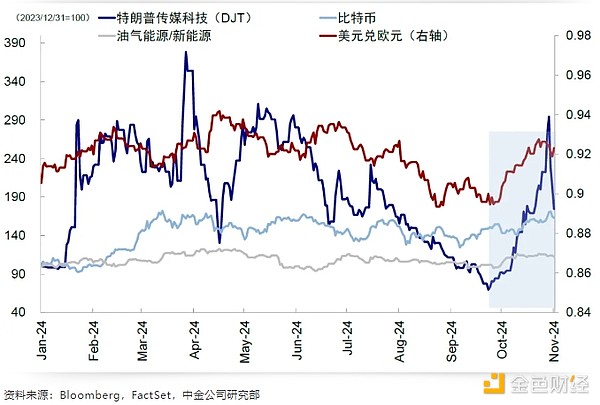
Chart: US stocks, US bonds, the US dollar, gold, TRON and the renminbi exchange rate have relatively more factored in the TRON trade expectations, but copper, crude oil and Chinese export chain stocks have relatively less factored in
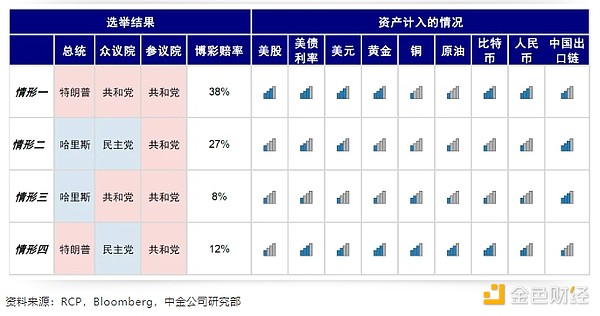
Based on this, our overall trading strategy recommendation is: 1) If the result is stronger than expected, i.e. a "Republican sweep" (TRON president + Republicans controlling both the Senate and the House), the current "TRON trade" will continue to have some upside room and amplitude for a period of time, but will then enter a period of pause waiting for the actual implementation of policies, similar to the surge after the 2016 election and the gradual pause after January 2017; 2) If the result is lower than expected, i.e. any scenario other than a "Republican sweep", especially if Harris wins the election, all trades will be directly reversed.
Chart: The experience of 2016: "TRON trade" → policy obstruction and pause → tax reform and restart
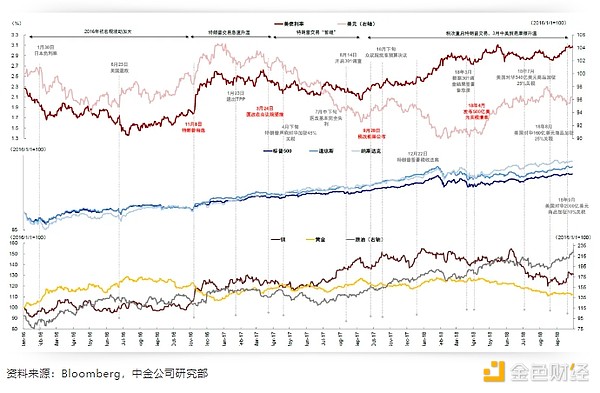
► A "Republican sweep" will strengthen the expectation of TRON policy implementation, forcing some previously hesitant investors to chase the rally quickly, which means the TRON trade as a whole still has some room, and the assets that have factored in less expectations will react more. 1) US stocks, US bonds, the US dollar and TRON still have the potential for a short-term rally, similar to the TRON trade in 2016, but the rebound amplitude will be lower than the previous round. After a period of time, the trade may pause or reverse. 2) In contrast, copper, crude oil, and the Chinese export chain face the risk of needing to compensate for the lack of expectation factoring. Copper, oil and other cyclical and resource-based risk assets may rebound under the expectation of reflation; gold, on the other hand, may reverse due to uncertainty-based hedging; the Chinese export chain may come under marginal pressure, with industries with low US export share and high US import share potentially showing relative resilience.
► Combinations other than a "Republican sweep" may all lead to a reversal of the TRON trade. For example, a Harris victory will directly lead to a reversal of the TRON trade, such as the US dollar and US bond yields, gold may pull back, and US stocks may also face some pressure, while other assets that were harmed by TRON policies will see pressure relieved. If TRON wins but the Democrats control the House, the implementation of their incremental stimulus policies may be obstructed, which will also cause a reversal of US bond yields and the US dollar, and US stocks will also face pressure, but the export chain will still be under pressure, while gold will continue to trade on tariff and geopolitical uncertainty.
In summary, the overall "contrarian" trading mindset has a better chance of success, but under a "Republican sweep" scenario, it will require more waiting time to let the bullets fly. US bonds provide trading opportunities after the rally; gold should watch for short-term overbought risks, with the rally offering partial profit-taking; US stocks and the US dollar are positive in the long run, but watch for short-term disruptions and wait for better opportunities; guard against risks in the export chain; copper and oil are neutral to bullish, waiting for catalysts.
Chart: Asset impacts under different scenarios: Scenario 1 sees demand and inflation rising together; Scenarios 2 and 3 maintain the status quo; Scenario 4 is stagflation
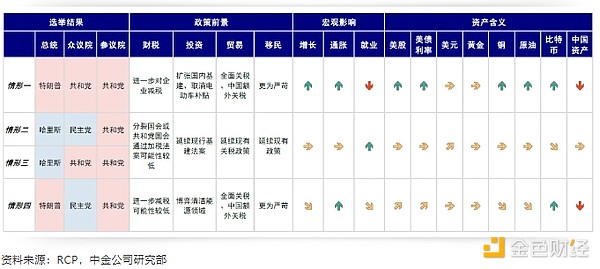
Risks
The election situation still has variables, poll data may have accuracy issues, and the speed and progress of policy implementation may not match market expectations.
[1]https://www.aljazeera.com/news/2024/10/31/route-to-270-how-trump-or-harris-would-win-the-us-election





